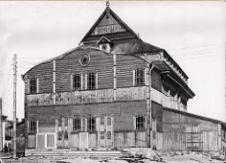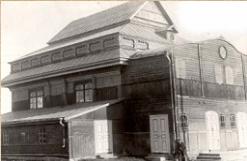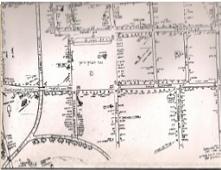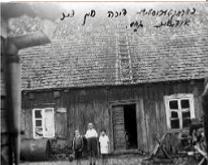VILKAVISKIS
A small town in Southern Lithuania
Where the Jewish Community is no more
Righteous Gentiles of Vilkaviskis
Šneideris, Juozas
Šneiderienė, Antanina
Žemaitaitis, Petras
Žemaitaitienė, Natalija
he elderly couple Juozas and Antanina Šneideris were farmers and lived with their daughter Natalija and her husband Petras Žemaitaitis in the suburbs of Vilkaviškis. In 1942 the Šneiderises accepted to their home at Sheina Weber (later Arkin), her two younger sisters and their friend Bela Zuker (later Sisna), who escaped the Vilkaviškis ghetto on the eve of it's liquidation on September 24, 1941. The four of them were hiding in forests for quite a long period of time, stealing food from the local peasants by nights. When the youngest of girls, who was only 14 years old then, got ill, the sisters were forced to apply to someone of the locals for help. They were lucky to find it in the Šneiderises house. Juozas Šneideris and his entire family were known for their liberal views. They gladly accepted the Jews thus showing their opposition to Nazism and nationalism. Šneideris and Žemaitaitis prepared a shelter in the barn's attic - not a very warm but a safe place to stay at, where the three Weber sisters and Bela Zuker were regularly provided with food, clean clothes and, once in a while, with hot water to wash themselves. More than two years, till the liberation day in August 2, 1944, the Jewish refugees stayed at the Šneiderises feeling like family members and trusting their hosts in every aspect. Only after the liberation they found out thet the Šneiderises also helped with food to their elder daughter, Adelė Jurevičienė*, who together with her husband also hid two Jewish women in their home. At the end of the 40-es all of the rescued immigrated to Israel.
On January 9, 1979, Yad Vashem recognized Juozas Šneideris, Antanina Šneiderienė, Petras Žemaitaitis and Natalija Žemaitaitienė as Righteous Among the Nations.
File 1327, 1327a
It was the father of Eli Rutstein who worked to get these saintly people recognised as Righteous Gentiles
The pictures were taken at Yad VaShem in 1979
An Interview with the Christian Lady
Part of an interview with Mrs. Nattily Zmintinah
I am not a lady - where there are servants there are ladies - but I am not a lady. I just saved some Jews during the war.
There were seven people, one of them was called Sperlingaite [ a Miss Sperling ] there where three sisters, Sheina, Zipora and Rasche, afterwards there was another sister that came from Poland.
One month before the Russian army liberated Lithuania, a number of Jews that had been in a railway wagon managed to cut a hole in the floor and escape. At least two couples escaped - the men went in one direction and the women in the other direction. The women where caught and handed over to the Germans, the men arrived at our village. I heard a noise and told my husband that the Jews had arrived. We asked them if they had been hidden somewhere else before they came here - they lied for they had been with a farmer who took their gold watch and then told them to leave. He did this more from fear. I took them to my husband and he gave them a spade and told them to dig a bunker where they could hide.
They built a bunker with a seat - they hid there for three weeks until the Russian tanks arrived. When the Russians arrived we parted from them with kisses.
What about the girls from Vilkaviskis ?
They were with us for the entire three years. At first they hid in a place that was covered with straw - the place was searched but they where not found. After that we built a window from glass so they could see if anyone approached and thus could escape via a tunnel. My mother was so happy that the three girls survived although they were very weak - they were not allowed to go outside.
Sperlingaite was very strong but the others were very weak we were afraid that they would go outside and give themselves up and us as well.
How old was Sperlingaite?
She had completed two years of her medical studies. Her parents had died of natural causes and she had a sister and brother in Israel. After the war she immigrated to America. [Sperlingaite probably refers to Yehudith Sperling, later Rubinstein, who settled in Milwaukee].
They Sperlingaite and a German refugee named Margot were hidden by my sister. The situation was as one can only see in films. They were hidden in a bunker in my sister's house - the German's commandeered the house. My brother said that we must save them or they would die of suffocation.
The house was guarded by a German soldier with a dog, my sister brought food for the dog and used the opportunity to enter the house - move the cupboard that him the entrance to the bunker and managed to get the girls out of the house.
Did you know that in Israel there is an institution called Vad Vashem that is responsible for remembering the Holocaust and that they search for the courageous non-Jews that saved Jews and give them the title of "Righteous Gentiles"
I need nothing; after all I was just fulfilling my responsibilities as a human being. My mother was a very religious woman. She said thank goodness that we were able to hide them for the entire period. Besides that we traveled to the ghetto and there we visited the daughter of Vintzburg, Loria.- Vintzburg was a very wealthy man and my mother did their laundry before the war. Four times we visited them and brought them food. They last time we came they were not there - we told that they had taken her father. We met Gordonisky and we gave him the food for Loria and we requested that he give the food to her and not eat it himself.
Here are the pictures of the girls before they left Lithuania
Interview with the Mayor
ÒDear Sir, [the Mayor is the son of Mrs. Nattily Zmintinah] a few minutes ago we interviewed your mother who saved Jews during the Second World War. She is a very kind and warm woman so very typically Lithuanian. We know that it was your initiative that brought about the creation of the monument to the martyrs of the Nazi regime.
On the monument is written in Russian and Lithuanian that the victims where Russian citizens and it is not mentioned that the victims were Jewish. On the monument there is not even one Hebrew lette ! Can you explain this?
When I became Mayor it was my aim to create a monument to the victims of the Nazis, and I think that in that I have succeeded. Regarding the text, when the monument was erected it was a period called the "strenitzia" and it was understood that one did not mention the Jews. In the meantime I have made a request to the Jewish community in Kovno and shortly it will be written in Yiddish and Lithuanian that at this site were murdered 6000 Jews.
Now to your second question, yes it is to our dishonor as Lithuanians and Vilkaviskites that the Jewish Cemetery is in such a poor condition; we are guilty. We have requested from the Jewish Community in Kovno how to make the improvements and we will provide the labor to accomplish this, to ensure that the cemetery is a fitting resting place.
I showed them a letter sent from Beit Hatefutsot two years ago.
I swear I have never seen this letter, I hope that when you come next year you will find that the situation has been rectified











